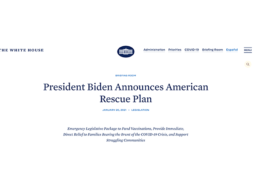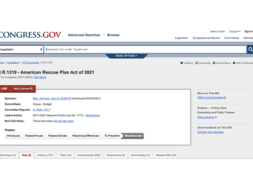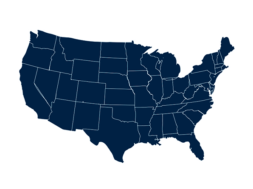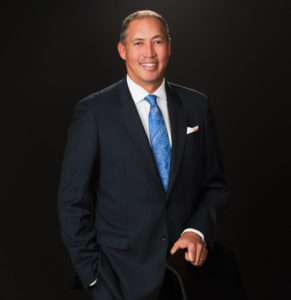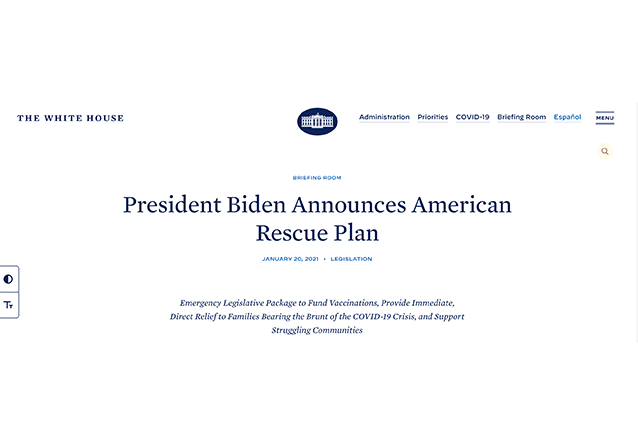
90/10 Provisions of American Rescue Plan Act of 2021 Brings Major Change
By Katherine Lee Carey, Special Counsel and Vince Sampson, Special Counsel, Cooley
For proprietary institutions subject to the 90/10 rule, President Joe Biden’s signing of the American Rescue Plan Act of 20211 on March 11 reflects a major change in this revenue test that provides for-profit institutions and their students access to the Federal Student Aid programs.
Under the currently effective Higher Education Act and its implementing regulations2, a Title IV-participating proprietary institution must annually derive at least 10% of its revenue “from sources other than Title IV, HEA program funds” in order to retain eligibility. If an institution does not meet this test for two consecutive fiscal years, it loses its eligibility to participate in the Title IV programs for at least two fiscal years, and if an institution does not pass the measure in any fiscal year, it becomes provisionally certified for the two fiscal years, requiring the institution meet a number of additional requirements.
This long-standing provision of the law governing higher education access for proprietary institutions has morphed numerous times over the years; however, the rule has remained consistent as to the basic premise that the revenue was divided into two buckets: Title IV funds and everything else. Although the calculation itself is complex, at least institutions could easily understand which funds fell into each side of the ratio. Not so now.
The 90/10 debate
Over the years, this rule has been the subject of heated debate. On one hand, impacted schools argue that this revenue measure does not reflect program quality, but rather, the socioeconomic status of the students enrolled. Title IV-eligible students are entitled to take out as much in federal student aid (both loans and grants) as they qualify for, and although an institution can counsel students about borrowing and debt, it cannot prevent a student from borrowing to the available limits. For many students, especially underserved minorities and working adults, the Title IV programs provide the only pathway to educational attainment as they do not have disposable income or savings to cover tuition and fees.
Institutions have long argued that the 90/10 rule only serves to inflate program costs because balancing the available aid against the formula often results in keeping tuition above the limits to provide for the required 10% of revenue.
On the other side, student advocates, especially those advocating for veterans attending higher education programs, have argued that in order to maintain a passing 90/10 score, institutions have targeted the veteran population because GI Bill and other VA program funds are not “Title IV, HEA program funds” and therefore fall into the “10 side” of the formula. Over the years, that limitation has been cited as a “loophole” and advocates have argued that a proprietary institution that has to rely on government funding programs for more than 90 percent of its revenue, regardless of what the government source is, should not be allowed to participate in the Title IV programs.
This issue had become such a hot button that attempts to change the 90/10 formula have occurred in numerous proposals in Congress over the past few years, with often mixed bipartisan support, but until the ARPA was signed, no other proposal had made it into law. In fact, the final language that cleared the Senate by voice vote was a significant departure from what was in the House-passed ARPA, and its inclusion was not guaranteed. Even though the language had cleared “Byrd Bath” and was germane to the reconciliation bill, proponents of closing the “loophole” understood that including delayed implementation was key to crossing the legislative goal line.
What has changed?
Under the ARPA, the HEA would be modified to change the formula from counting only Title IV program funds on the “90 side” to include instead all ‘‘federal funds that are disbursed or delivered to or on behalf of a student to be used to attend such institution” or collectively “federal education assistance funds.” This is a substantial change, and the impact is not entirely clear. Although the argument in support of this change was to protect veterans, the wording choice is broad enough to raise questions about the full scope. The open-ended nature of the term “federal education assistance” raised alarm bells for proprietary schools and many members of Congress, and the initial plan to make the provision immediately effective turned up the volume on those alarms.
As noted above, the 90/10 calculation is conducted annually, based on the institution’s fiscal year cycle. To have a change to revenue recognition in the middle of a fiscal year would have been extremely complex and difficult to audit. Additionally, for schools that serve a heavy veteran population, this new rule may require that they cease, or at least limit, the number of veteran students they serve in order to prevent a failing 90/10 score.
Without a ramp-up period, schools might have been forced to withdraw veteran students in the middle of training to avoid an inadvertent failure.
What is also not clear is whether other federal funds, such as Department of Defense Military Tuition Assistance program, Workforce Innovation and Opportunity Act and Trade Adjustment Assistance, will be included in the new definition, despite not being discussed as an impetus for the change. Had this law gone into effect without further clarification, it would have resulted in institutions flying blind while trying to implement it.
Because of these pressing concerns about timing and scope, eventually a compromise was reached. Typically, any new law that impacts the federal student aid programs must go through a negotiated rulemaking process and align with the “master calendar,” which provides for input from constituencies as well as aligning the timing of the change to the Department of Education’s award year. In the final language of the ARPA, the new 90/10 provision will be subject to negotiated rulemaking after October 2021, with an earliest effective date in fiscal years starting on or after January 1, 2023.
What should institutions be doing now?
If your institution is subject to this rule, the first step is assessing how your revenue ratio would fare if all GI Bill and TAP funds were moved to the “90 side” of the ratio. Because the scope of the definition is currently unclear, schools should also test the ratio with all federal funds moved to the other side, including WIOA and TAA. Conducting this assessment now is the best way to start preparing to adjust enrollment levels.
We expect the Department of Education to conduct negotiated rulemaking as soon as allowable under the ARPA. This process will be key to defining what funds will count as “educational assistance” as well as any reporting or enforcement mechanisms. During this process, constituents are encouraged to review proposed rules and lodge comments. We encourage all impacted institutions to engage in the rulemaking process and closely track the proceedings so they are prepared to make necessary adjustments in advance of a new rule being implemented.
If you have questions about the 90/10 provisions of the ARPA, reach out to Cooley’s EDU team at https://ed.cooley.com/.
References
- H.R.1319 – American Rescue Plan Act of 2021, Public Law No: 117-2
- 34 CFR § 668.28
KATHERINE LEE CAREY’S practice focuses on the legal, accreditation, administrative and regulatory aspects of regionally and nationally accredited higher education institutions and companies that provide services to the education industry. She provides clients with interpretation and implementation guidance on legal and regulatory changes, including impact analysis and strategic plans to implement complex regulatory requirements and compliance structures.
Katherine has extensive experience in the development and implementation of legislative and policy priorities at the federal and state levels and in accreditation and licensing matters, including ACCSC, ACICS, ABHES and WASC.
Prior to joining Cooley, Katherine was the general counsel and vice president for government affairs at West Coast University and American Career College in California. She is a member of the California Association of Private Postsecondary Schools (CAPPS) and chair of the advisory board for the California Bureau for Private Postsecondary Education (BPPE).
Contact Information: Katherine Lee Carey // Special Counsel // Cooley // 858-550-6089 // kleecarey@cooley.com // https://www.cooley.com/people/katherine-lee-carey
VINCE SAMPSON focuses on helping clients predict, navigate and understand the increasingly complex involvement of federal agencies and Congress in the regulation of the education, technology, financial services, life sciences and communications industries.
Vince regularly guides clients through the legislative and regulatory processes, advising them on potential risks and developing strategies focused on informing business decisions. These strategies include building coalitions, drafting letters to policymakers and creating other informative materials. In addition, he provides insight and advice on responding to congressional inquiries and investigations from the point of initial outreach to potential hearings and testimony.
Most recently, Vince was president of the Education Finance Council, the trade association representing nonprofit and state agency student finance organizations. He served as the organization’s chief representative on Capitol Hill, with the Executive Branch, and within the higher education community, working to advance the council’s goal of increasing accessibility and affordability for postsecondary education.
Prior to joining the Education Finance Council, he served as the principal deputy assistant secretary, policy planning and innovation in the US Department of Education in the Office of the Postsecondary Education. He also served in the Office of Legislative and Congressional Affairs, where he was senior counselor, with responsibility for oversight matters.
Vince joined the Department of Education in 2007 after serving as deputy chief counsel for the Committee on Resources in the US House of Representatives. Preceding his Hill experience, he worked in various capacities in the private sector, including as vice president for public affairs at the Association for Competitive Technology.
Contact Information: Vince Sampson // Special Counsel // Cooley // 202-728-7140 // vsampson@cooley.com // https://www.cooley.com/people/vince-sampson
